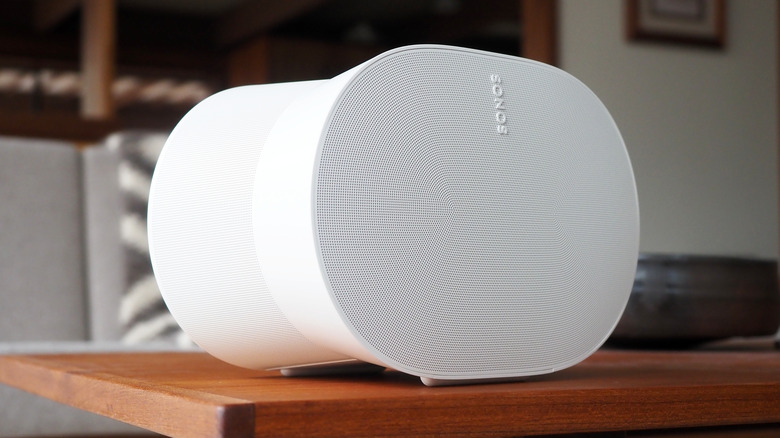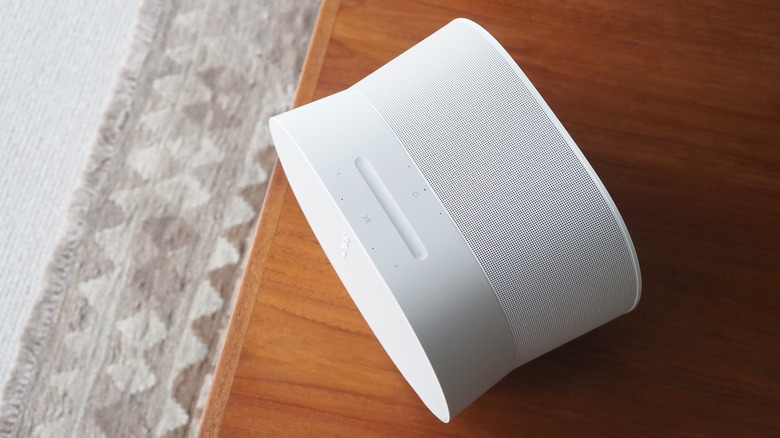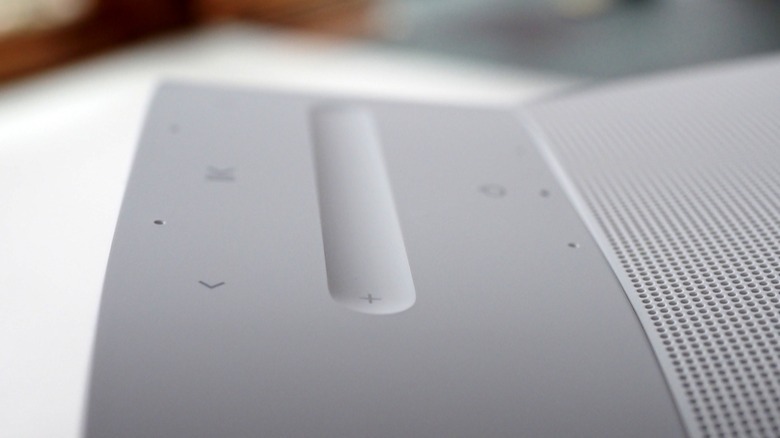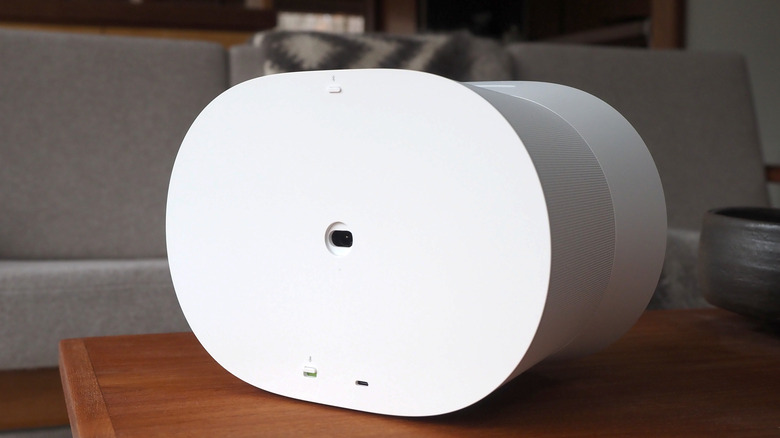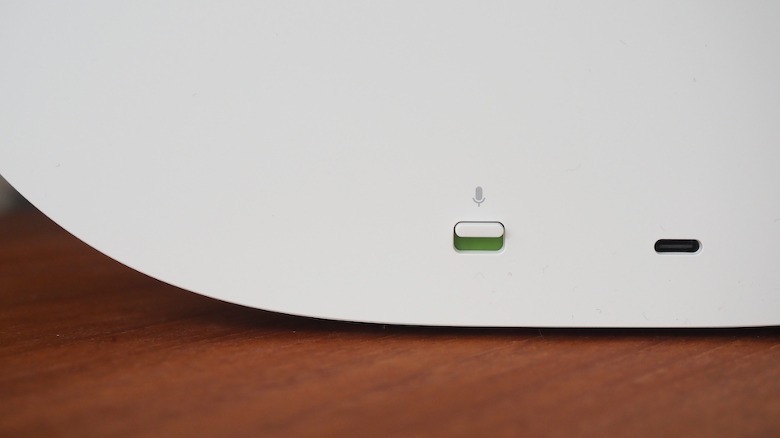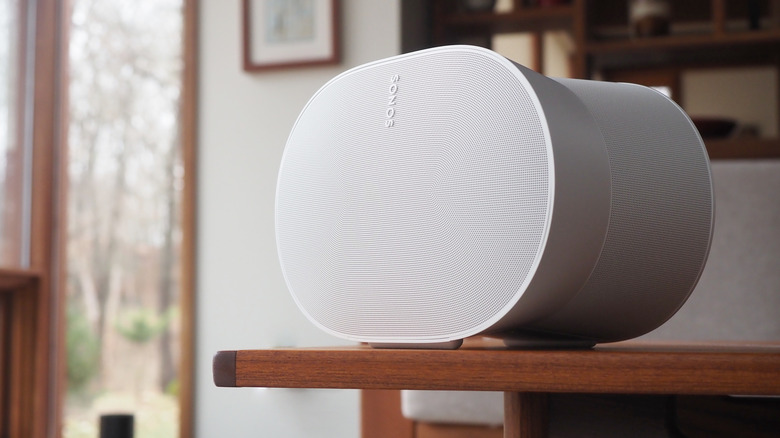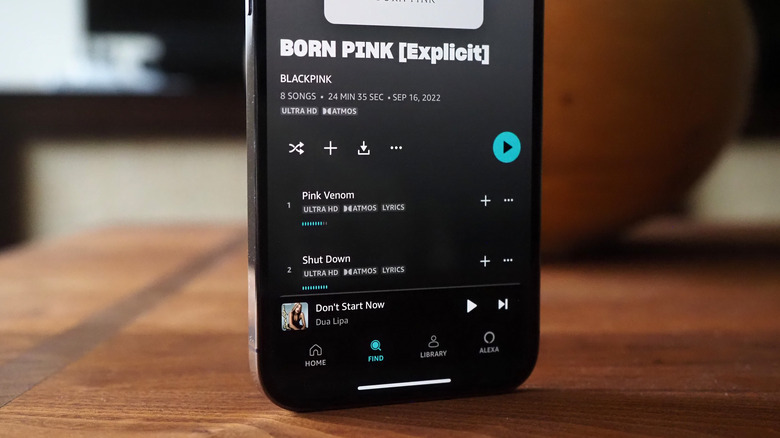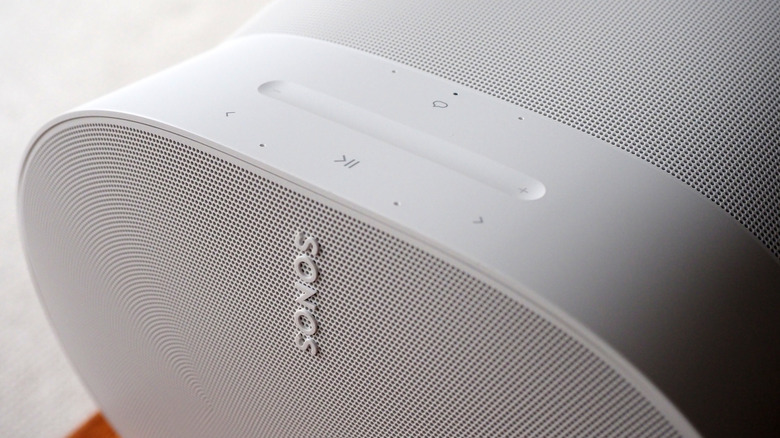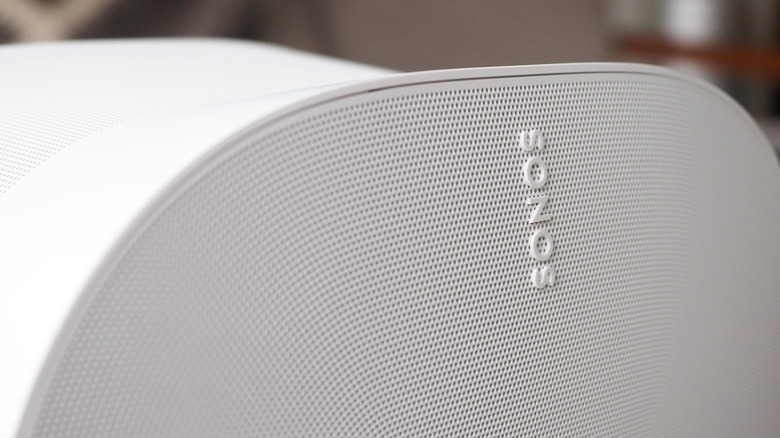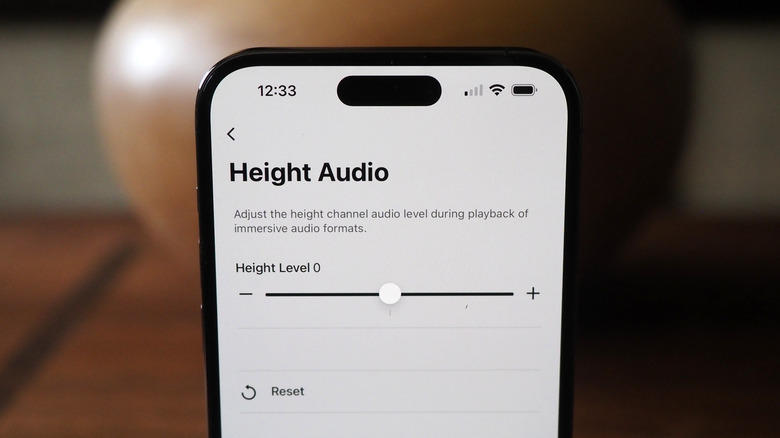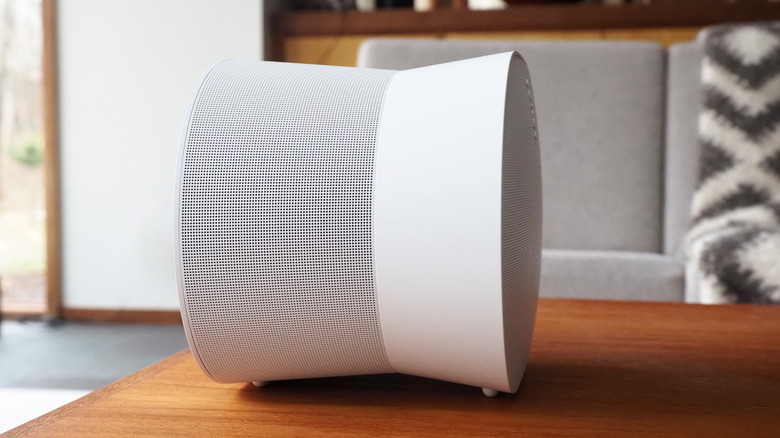Sonos Era 300 Review: More Than Just A Spatial Audio Speaker
- Spatial audio sounds great, not gimmicky
- No sacrifice for stereo tracks
- More flexible connectivity
- Boosts Atmos home theater performance
- Finding Dolby Atmos music can be frustrating
- Expensive for a stereo pair or theater setup
- No Google Assistant at launch
Once upon a time, stereo music was considered a gimmick. Now, it's the turn of spatial audio to win over audio skeptics, and that's a challenge the Sonos Era 300 believes it's ready for. The multi-room speaker company's latest model looks like no Sonos before it — form follows function as it sprays sound in all three dimensions.
At $449 it slots in between the Sonos-One-replacing Era 100, and the stalwart — and still pretty sublime — Sonos Five. It also, unofficially but unmistakably nonetheless, occupies the space once held by the Play:3, a midsize speaker that plenty of Sonos fans still think highly of. Where the Play:3 was squeezed out of the range by its siblings, though, the Era 300 stands out by virtue of doing something new.
Dolby Atmos music — also known as spatial or 360 audio — adds height to what we're familiar with. Rather than simply directing two channels of audio, left and right, as a stereo speaker would, the Era 300 can more specifically position it within the room, including overhead. That gives musicians and their producers an opportunity to do new, more immersive things with their tracks, though as with any new format, there are some hurdles to clear along the way.
An unusual design to accommodate six drivers
While Sonos says its design was led first by audio performance, happily that doesn't leave the Era 300 looking like a monstrosity: more as though a regular speaker has been pinched in around its waistline, the home audio equivalent of wrapping rubber bands around a watermelon. Compared to Sony's SRS-RA5000, which resembles the disconcerting mashup of an electric shaver and a Xenomorph egg, Sonos' aesthetic is far more refined.
The Era 300's angles allow the side and top drivers to fire out as appropriate. There are six drivers in total: two woofers on the bottom corners responsible for the low-end, and two mid tweeters on the speaker's top shoulders that use waveguides to direct the sound outwards. A mid tweeter in the front handles the center channel, while a directional horn tweeter on the top bounces its sound off the ceiling, for the height effect.
It's all wrapped in Sonos' familiar matte plastic, in white or black, with finely perforated grilles. On the top there are touch-sensitive buttons for play/pause, skipping tracks, triggering the voice assistant — initially either Amazon Alexa or Sonos' own Voice Control, with Google Assistant support still on the roadmap — and a long groove along which you can slide your fingertip to adjust volume.
Connectivity and setup improvements
A physical microphone mute switch is on the rear, for those who really want to be sure that the Era 300 isn't listening. Connectivity gets an upgrade compared to other recent Sonos speakers, with both WiFi 6 and Bluetooth 5.0. However, there's no ethernet jack: if you want to use a wired connection, you'll need Sonos' $39 Combo Adapter that plugs into the freshly-added USB-C port on the rear.
That adapter can also be used to pipe in an external audio source via a 3.5mm jack; Sonos will also have a simple $19 line-in adapter that ditches the ethernet connection. Bluetooth line-in is also supported, plus Apple AirPlay 2, and — whether wired or wireless — you can listen to that music on the Era 300 alone or distribute it across other Sonos speakers in the home.
As before, you can use Sonos' Trueplay to automatically adjust the EQ to suit the acoustics of the room, but now there are two ways to do that. The existing method — where you walk around, waving an iOS device like a Tricorder while the speaker plays warbling sounds for about a minute — is now referred to as "advanced tuning." A new "quick tuning" version relies on the microphone in the Era 300 itself and happens much more rapidly (as well as being accessible to Android users).
I couldn't immediately notice a difference between the two, though either way, spatial audio sounded better after Trueplay than before it. Regardless of whether you use it or not, you can subsequently adjust the bass, treble, and loudness in the Sonos app, as you might with any of the company's speakers. The Era 300 also gets manual height audio adjustment.
Dolby Atmos music sounds unexpectedly good
The good news is that Dolby Atmos music on the Era 300 generally sounds really good. I've been skeptical of spatial audio in the past, finding it to often be gimmicky: artificially broad soundstages, instruments and singers placed to showcase the technology rather than emphasize the music, and distractions like head tracking. Often it just feels like it's trying too hard, like the early days of surround sound where movies weren't complete without a helicopter buzzing just over your head.
Sonos' flavor of Atmos feels more natural, though, of course, we're working with plenty of variables here: what you hear will depend just as much on the track's producers as the Era 300. Still, in general, spatial audio feels more encompassing, like the musicians and singers are arrayed out on a stage in front of you, rather than coming from a single, tighter point.
You notice it most when flipping between spatial and stereo tracks. The former feel airier and more expensive; less like they're overlapping in their complexity. Again, it's not a dramatic effect, and I don't think I'd want it to be: people I played Atmos music to didn't immediately start looking around, wondering where I'd hidden the extra speakers, but they did agree that it felt more immersive than the stereo tracks did.
The user experience isn't as slick as the sound
The downside is that actually finding Atmos music can be a chore. During my testing there's only been one source of it: Amazon Music, which requires a $10.99 monthly subscription (or $8.99/month if you're a Prime subscriber). As of March 28th, that'll be joined by Apple Music, though if you're a Spotify subscriber you're out of luck. The Era 300 can't accept spatial audio over Bluetooth or Apple AirPlay 2, either, or via the line-in adapter.
Building a playlist requires some app juggling, and is really not as straightforward as it could be. As before, you can search across all your registered streaming services within the Sonos app, but there's no indication there as to which tracks are spatial and which aren't. The only time you see that is while the audio is actually playing, and even then you need to open the full "Now Playing" view to see the Dolby Atmos icon since it doesn't show up in the minimized view.
There's no way to filter a search by spatial audio only (and, on the flip side, for the moment you can't turn spatial audio off; Sonos says that setting is coming), and, more confusing still, the same song on different albums can be Atmos or non-Atmos. In the image above, for example, only the first track in the search results is an Atmos version. I found myself flipping between the Amazon Music app — which does at least have a section for spatial audio, even if some albums marked as such only have a subset of their tracks that actually use Atmos — and the Sonos app, trying to match the album art thumbnails so that I was getting the right version.
Stereo music devotees aren't left out
Eventually – and probably easiest in the Amazon app — you'll likely have built some Atmos playlists that you can then summon from Sonos' interface. Nonetheless, when it comes to showcasing the Era 300's talent, the thought of curating new releases that take full advantage of the hardware here starts to feel like a chore rather than relaxation.
After a while, and growing increasingly frustrated, I gave up on specifically hunting out Atmos music and just listened to the tracks I like. Sonos doesn't do any artificial processing to non-Atmos music, the spatial-style equivalent of video upscaling to turn regular stereo into something more immersive, but that doesn't matter. Thankfully, the Era 300 sounds great either way.
There's still a sense of extra width to the soundstage, even with just stereo music, beyond what the old Play:3 or a Sonos Five can deliver. That's undoubtedly down to the angles that the drivers are pointed at, spreading audio on either side of the speaker rather than firing it all forward. The downside is that, in a more enclosed space like a bookcase, the stereo-only models have a little greater clarity to my ears.
A speaker sweet-spot
Positioned out in the open, though, and the result belies the Era 300's size. A Sonos Five is still more powerful, but unless you're roaming up to the top end of the volume scale, I'm not sure most rooms require it. The directional drivers — still used for stereo music — help fill the space, meaning there's less of a sweet spot you need to be sitting in to hear the track properly.
Sonos' usual, fairly transparent delivery is present and correct. No over-emphasis on bass, and no punch to the high-end either. It all sounds very natural. I've been particularly enjoying vocal-first tracks, where the center driver's focus plays nicely with the more spacious backing.
Compared to a set of Sonos One (themselves superseded, now, by the Era 100) in a stereo pair, I prefer the Era 300. Not that the smaller speakers are lacking, but even linked they don't have quite the room-embracing airiness that this spatial speaker does.
An expensive home theater upgrade, too
Like most Sonos speakers, the Era 300 can be used as rear surround channels with one of the company's soundbars. Sonos began supporting Dolby Atmos for video content with the Arc — and subsequently added it to the Beam (Gen 2) — though these new spatial-ready speakers do promise some fresh talents above, say, a pair of Sonos One, Five, or even a Sonos Architectural setup.
That's because the Era 300 is the first time Sonos has supported multichannel rear surround sound: taking advantage of height information in Atmos content, just like the soundbar up-front does. Unfortunately, since Sonos only provided a single Era 300, I couldn't test this out myself. In a demo by the company, however, there was a noticeable sense of height to audio coming from behind you.
As before, your home theater system might require some other upgrades before you can take full advantage. The soundbars rely on an HDMI eARC connection to the TV for passing through Atmos audio, and you'll also need a suitable source of that content. Many services charge a premium for that — if they offer it at all. An Arc setup with a pair of Era 300 speakers won't be cheap, either: Sonos has a bundle of all three, at $1,717, or $2,471 if you want a Sub as well.
Sonos Era 300 Verdict
Sonos is hardly known for being inexpensive, of course. Its selling point has always been convenience as much as sound quality, plus the ability to give you room — and multi-room — filling audio without requiring a whole bunch of ugly speakers. On that front, the fact that the Era 300 delivers convincing spatial audio without resembling an AI design glitch in the process is particularly welcome.
More unexpectedly, what stands out is how successful the Era 300 feels, even if you don't care at all about spatial audio right now. That's a stance I can well understand, for the moment at least — Atmos music's relative rarity probably being the most significant issue — but it's hard to argue with the sweet spot this new speaker finds itself in. More serious (and capable) than a Sonos One or Era 100, but more affordable than a Sonos Five, the spatial audio may be the first selling point, but the Era 300's charms run deeper.
The Era 300 can be purchased from the Sonos store for $449 in black or white.
